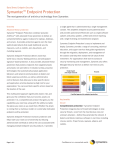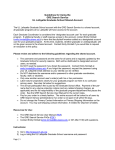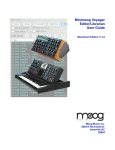Download exercises - Bryn Mawr Computer Science
Transcript
BIOL/GEOL 361: Emergence 1 Avida: Digital Life Simulation AVIDA: DIGITAL LIFE In 1999, two scientists at Michigan State University founded the MSU Digital Evolution Laboratory to establish a research program dedicated to the simulation of evolution. The lab has two goals: to experimentally study digital organisms to improve our knowledge of how evolution works and to apply that knowledge to the problem of solving computational problems (i.e., assuming that evolution is an optimization algorithm). One of the products of the research initiated in this lab has been the development of auto-adaptive genetic system, Avida. This system is a simulation environment that creates a digital world in which self-replicating computer programs mutate and evolve through the use of genetic algorithms. COMPONENTS OF THE AVIDA WORLD Like any other genetic algorithm, Avida works by generating a random population of individuals, evaluating the fitness of each, choosing the most fit to reproduce and persist, randomly combining potential parents to create new offspring, randomly mutating individuals in the offspring population to introduce new variation, and then repeating the cycle until some goal is reached. To understand how Avida works, therefore, we need to understand all of these components. The Individual: A Digital Organism In the Avida world, each organism is actually a virtual computer that executes simple logical instructions! This is not an unrealistic model for life, because brains are types of computers (i.e., they are “devices” that receive data as input, process and manipulate the data, and then produce some output, such as a trigger for the behavioral response to the input). In Avida, each individual's body is a virtual CPU, made up of the following “organs” (see the Figure): • • • • • A memory that consists of a sequence of instructions. This memory is the organism's genome that will evolve through the use of a genetic algorithm. An instruction pointer (IP) that keeps track of what instruction the organism is executing Three registers that can be used by the organism to hold data currently being manipulated. Two stacks that are used for storage (of data and the organism’s status). An input buffer and an output buffer that the organism uses to receive information and return the processed results. BIOL/GEOL 361: Emergence 2 Avida: Digital Life Simulation • A Read-Head, a Write-Head, and a Flow-Head which are pointers used to specify positions in the CPU's memory so that instructions can be executed. For example, a copy command reads from the Read-Head and writes to the Write-Head. Jump-type statements move the IP to the Flow-Head. The Genome All organisms in Avida have the same body plan. What evolves in this simulation is not the phenotype or organization of the digital organism, but its memory, which provides the set of instructions that determine how the virtual CPU processes information. This set of instructions is the genome of the individual (see above Figure). The set of instructions was developed with four things in mind: • • • • To be Turing complete: i.e., have the ability to compute any computable function To ensure that simple operations can be accomplished with few instructions For each instruction to be as robust and versatile as possible To have as little redundancy as possible between instructions. There are 4 types of instructions: • • • • No-operation (nops) commands: have no direct effect of the virtual CPU, but modify the effect of any instruction that precedes them (regulatory genes) Instructions unaffected by nops, mainly biological instructions involved in replication. Instructions in which a nop changes the head or register affected by the previous command (e.g., an inc command followed by nop-A would cause the contents of register AX to be incremented). Instructions that use a series of nop instructions as a template (label) for a command that needs to reference another position in the code (e.g., if an instruction tests if ?BX? is equal to its complement, it will test if BX == CX by default, but if it is followed by a nop-C it will test if CX == AX). There are 26 basic instructions that an individual can perform: Instruction (a-c) (d) (e) (f) (g) (h) (i) (j) (k) (l) (m) (n) (o) nop-A, nop-B, nop-C if-n-equ if-less pop push swap-stk swap shift-r shift-l inc dec add sub Description No-operation instructions; these modify other instructions. Execute next instruction only-if ?BX? does not equal its complement Execute next instruction only if ?BX? is less than its complement Remove a number from the current stack and place it in ?BX? Copy the value of ?BX? onto the top of the current stack Toggle the active stack Swap the contents of ?BX? with its complement. Shift all the bits in ?BX? one to the right Shift all the bits in ?BX? one to the left Increment ?BX? Decrement ?BX? Calculate the sum of BX and CX; put the result in ?BX? Calculate the BX minus CX; put the result in ?BX? BIOL/GEOL 361: Emergence 3 Avida: Digital Life Simulation Instruction (p) (q) (r) (s) nand IO h-alloc h-divide (t) h-copy (u) (v) (w) (x) h-search mov-head jmp-head get-head (y) if-label (z) set-flow Description Perform a bitwise NAND on BX and CX; put the result in ?BX? Output the value ?BX? and replace it with a new input Allocate memory for an offspring Divide off an offspring located between the Read-Head and Write-Head. Copy an instruction from the Read-Head to the Write-Head and advance both. Find a complement template and place the Flow-Head after it. Move the ?IP? to the same position as the Flow-Head Move the ?IP? by a fixed amount found in CX Write the position of the ?IP? into CX Execute the next instruction only if the given template complement was just copied Move the Flow-Head to the memory position specified by ?CX? So, to provide an example, we could define the genome of an organism as follows: # --- Setup --h-alloc # Allocate extra space at the end of the genome (for # an offspring h-search # Locate an A:B template (at the end of the organism) # and place the Flow-Head after it nop-C # nop-A # mov-head # Place the Write-Head at the Flow-Head # (which is at beginning of offspring-to-be). nop-C # [ Extra nop-C commands can be placed here w/o # harming the organism! ] # --- Copy Loop --h-search # No template, so place the Flow-Head on the next # line code h-copy # Copy a single instruction from the read head to the # write head (and advance both heads!) if-label # Execute the line following this template only if we # have just copied an A:B template. nop-C # nop-A # h-divide # ...Divide off offspring! mov-head # Otherwise, move the IP back to the Flow-Head at the # beginning of the copy loop. nop-A # End label. nop-B # End label. This genome is a program that provides the set of instructions that the organism will use to replicate itself. It begins by allocating extra space for its offspring. The organisms will then search for the end of its genome (where the new space was placed) so that it can start copying. Next, the actual copying begins. We don't need to understand the exact details of this process, but you can work it out if you go through the list of commands provided earlier and read the comments carefully. Replication is program that can be encode in an Avida genome. We can extend the genome so that the organism can complete other tasks, such as logically evaluate and BIOL/GEOL 361: Emergence 4 Avida: Digital Life Simulation process input from the environment. For example, listed below is one possible set of instructions that an individual could use to perform or comparisons: Line # 1 2 3 4 5 6 7 8 9 10 11 12 13 14 15 Instruction IO push pop nop-C nand nop-A IO push pop nop-C nand swap nop-C nand IO AX ? ? ? BX X X X CX ? ? X Stack Output ? ? X, ? ? ~X X X ? ~X ~X ~X Y Y Y X X Y ? Y, ? ? ~X Y ~Y ~Y Y ~X ? ? Y Y X or Y ~X Z ~X ? ? X X or Y This is rather complex, and luckily for the most part we won't have to deal with this code directly. But it is still useful to have a conceptual understanding of what is being evolved. Fitness The fitness of an individual in the Avida is measured as a function of stored energy and is biologically equivalent to the concept of metabolic rate. The metabolic rate is calculated as the amount of stored energy divided by the number of instructions (including those involved in replication) the organism can execute before running out of energy. Thus, an organism with a higher metabolic rate must use more energy to execute instructions (i.e., perform bodily functions) than one with a lower rate. An organism must pay both virtual CPU cycle and energy costs to execute instructions. As instructions are executed the organism's stored energy level is reduced. New energy can only be absorbed after the organism completes its task. Thus, an “optimal solution” is one that uses the fewest instructions (and thus less energy) to complete a task. BIOL/GEOL 361: Emergence 5 Avida: Digital Life Simulation AVIDA-ED One of the nice things that MSU has developed is an educational version of the Avida simulation, Avida-Ed, that provides a wonderful visual interface to the workings and evolution of an Avida world. It is this piece of software that we will be using today. You can download it from the class website. The user’s manual is also available for download. Avida-Ed simulates the a population of Avida digital organisms evolving in a Petri-dish. It allows you to graphically to create an ancestor from which the initial population is generated, specify the fitness function, save populations (by freezing) for later analysis or evolution, and view the details of the evolutionary process. EXERCISES Today’s exercise is mainly exploratory, just complete the following. Before you begin, however, some points to keep in mind: • Printing and saving of graphs, populations, and organisms does not work so you can take a screen snapshot if you want to compare side by side or save any graphs • You can export some basic population statistics • You can save any thing that you evolve by saving the workspace and freezing populations/organisms. You can always re-start your simulation from the frozen point. • Please note that this software is a work in progress. 1. Download and install the Avida-Ed software from the course website. I have also provided a link to a Mac version for those of you who have Macs at home. 2. With a partner, work through the user’s manual and familiarize yourself with the environment. 3. Switch to the organism view and drag the @ancestor to the lab bench from the freezer. Run the ancestor. What happens? 4. Drag the @example provided in the frozen populated dishes to the lab bench. View the environmental settings so that you understand what is going on. a. Run the simulation, setting the color scale to report fitness levels. What happens to average fitness over time? Do you reach a point when fitness no longer improves? b. After a while, pause the simulation and select one of the more fit organisms. Drag that organism to the freezer, name it, and switch to organism view. c. Drag your frozen organism to the freezer and run it. How does it compare to the ancestor? Is it more or less efficient? How different is its genome BIOL/GEOL 361: Emergence 6 Avida: Digital Life Simulation 5. Switch back to your population view and drag the frozen empty population to the Petri-dish (i.e., start a new simulation). Now drag your frozen ancestor to the empty dish and start the simulation. How does this compare to the default simulation that started with the example ancestor? 6. You can run simulations starting with multiple ancestors. Try it. 7. Do something novel. For example you could: a. Create at least one new ancestor b. Create a new workspace with an empty Petri-dish c. Change the environmental settings. d. Run your Avida world with your new ancestor. Explain what you did, what resulted, and what you learned. 8. What insight has this exploration given you into the workings of GAs? What questions do you still have?












